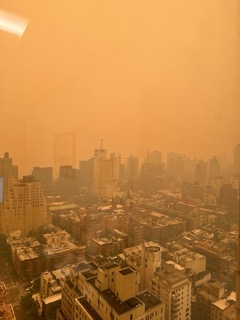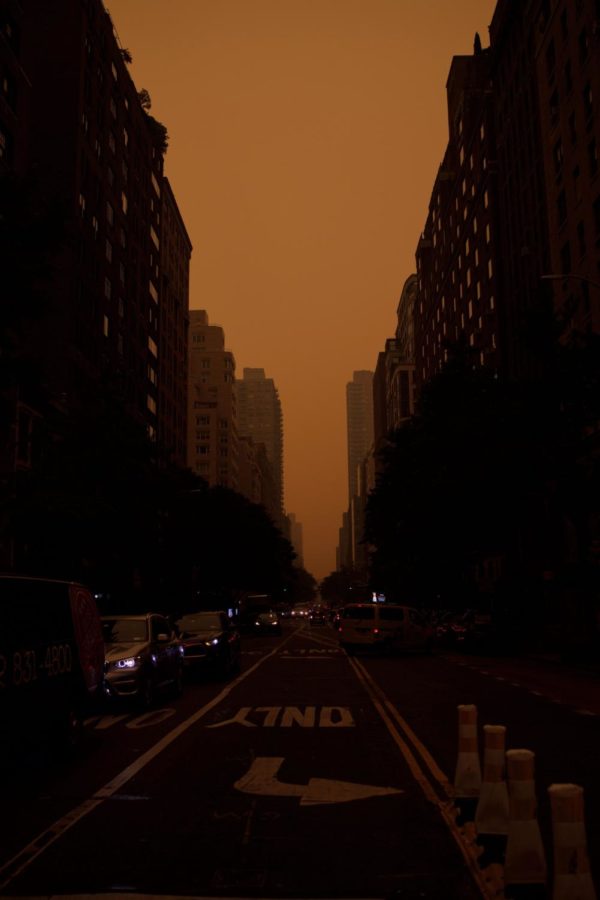The ‘End of Days’ in New York City: Climate Change and the Canadian Wildfires
On Wednesday, June 7th, 2023, smoke from Canadian wildfires engulfed New York City. In the next few days, it spread across the East Coast. In what ways can we act to prevent this ‘canary in a coal mine’ in terms of climate change from impacting our collective future?
Smoke-filled skies on Wednesday, June 7th, 2023, forced New Yorkers to look at climate change head on.
There was a phrase people kept repeating in New York City on Wednesday, June 7th, 2023 — the ‘end of days.’ “It looks like the end of days out there,” or “My God, this is what the end looks like.” I was in school at The Bronx High School of Science when the sky turned red. A few of us had heard about the wildfire smoke from Canada on the news that morning, so most of us knew what was happening, but it was a few hours before the whole school community caught on. Wildfires were raging in Canada, and smoke was making its way through the city. We knew that this kind of event has been happening in California, and has been spreading across the world, for years. So I knew, logically, that the world wasn’t ending, that there would be smoke for a few days, and then things would go back to normal.
But logic didn’t make it look less like an apocalypse.
The air was a thick blood orange – each breath pulled a bonfire into our lungs. I mostly remember the visual snapshots from the day: the lights off in every room, and students clustered around red-tinted windows. There was a ninth grader on the phone, worriedly telling the person on the other end that it was hard to breathe. There were more students in masks than I have seen seen since last year, and I witnessed a group of juniors wearing wet bandanas around their mouths and noses.
I talked to one of my teachers about how afraid we were. He told me he was scared that, at his age, he wouldn’t be able to keep his health amidst the environmental destruction. I, in turn, told him that I was afraid to have children later in life – afraid to bring new life into a world falling apart, afraid that my child would never feel the soft kiss of snow on their cheeks, afraid that my child would never be able to walk outside and breathe in fresh spring air.
Fear was a theme that day. Most of us had never seen anything like this, and there are few things as frightening as the unknown. All day, I was getting calls and texts, from friends who had seen a photo somewhere on the internet and wanted to check in, from family friends sending pictures from street corners and high rise offices, and from out-of-state family lamenting about ‘the state of things.’ A few students who had moved to the city from western states were more familiar with smoky skies. They were a bit less panicked, but not by much.
On Wednesday, June 7th, 2023 , there was nowhere in the world with worse air quality than in New York City. Our air was more contaminated than it’s been since the Bronx burned in the 1980s – worse, even, than it had been on 9/11. All five boroughs were under an ‘air quality advisory.’ New Yorkers were encouraged to stay inside with doors and windows closed, and the New York City Department of Education canceled school on Friday, June 9th, 2023 to allow students to meet virtually from home with their teachers in the interests of safety (Thursday, June 8th, 2023 was a staff development day with no student attendance; faculty across the city met virtually on this day, from home, as well, in the interests of safety).
Though the wind has currently spared New York City from the smoke for now, Canada’s wildfires are still burning, and the smoke is still traveling to other parts of the United States. On Monday, June 12th, 2023, Philadelphia experienced a ‘Code Orange,’ meaning that their air was actively dangerous for young children, the elderly, and those with pre-existing conditions. As of June 15th, 2023, 451 fires were still active in Canada, almost half of which were ‘out of control.’
Canada, like many other countries, experiences a ‘wildfire season’ every year, but this year is different. In 2023, the amount of land burned has exceeded 4,000% of the average over previous years. These larger fires are more difficult for local fire departments to contain. In addition, around a third of the fires have been in eastern Canada, where wildfires were a rare occurrence — until now. These larger fires in new regions of the country mean one thing – Canada simply doesn’t have the infrastructure to handle this wildfire season.
Julia Jacobo from ABC News delivered a grave warning, writing that, “As the wildfires continue in Canada and eventually start on the West Coast of the U.S., the smoke being emitted from the heavy flames will continue to compromise air quality as it moves east.” Michael Flannigan, a researcher of wildfires at Thompson Rivers University, concurs, telling CNN that “all indications” suggest that the fires and smoke will worsen throughout the summer.”

It’s hard to even estimate the long term impact that this smoke will have upon our health. From increasing the chances of different cancers and causing breathing difficulties to putting toxins in our water sources and farms, one thing is clear: if this smoke continues throughout the summer, we could see a significant decline in the health of New York City residents.
This will impact all of us, but some populations may feel the effects more directly. Certain people are more vulnerable due to pre-existing physical conditions — the chronically ill, newborns and the elderly, and pregnant women – but other groups have been made vulnerable by societal factors. Black Americans, who already bear the brunt of pollution related health harms, will be disproportionately harmed by this smoke.
It’s important to remember that the dry heat that Canada has experienced in recent months is not a fluke of nature, or a normal climate fluctuation. We stole the moisture from the ground, we scorched the earth around the forests, and we lit the match. Humans did that, with our oil pipelines and our clothing brands and our farms. It’s also important to remember that this type of destruction isn’t inevitable, that it isn’t the price of progress. Civilizations all over the world have once functioned sustainably – the original inhabitants of North America, in fact, functioned sustainably.
This is a choice that we’ve made. I know that we don’t all have equal bargaining power — this is important to note, too. The working classes shouldn’t shoulder the same amount of responsibility as the rich, and those excluded from politics are much less responsible than those in power. But those of us with the most bargaining power have chosen this current world for all of us, and it’s now up to the rest of us to make our choice – we can either be complacent or we can act. If we choose complacency, we choose red skies and smoke-filled air and children who don’t know a life without fear. But if we choose to act — and we can choose to act — we choose a chance at creating a better world for the next generation.
It’s important to remember that the dry heat that Canada has experienced in recent months is not a fluke of nature, or a normal climate fluctuation. We stole the moisture from the ground, we scorched the earth around the forests, and we lit the match. Humans did that, with our oil pipelines and our clothing brands and our farms.
Acadia Bost is a returning Editor-in-Chief for ‘The Science Survey.’ Placing an emphasis in their writing on the more structural, long term problems...

